Chat GPT is the buzzword all around. The use of AI in recruiting and sourcing has been quite prominent especially in terms of leveraging it to source and qualify candidates. We are living in a talent eco system where companies are heavily invested in using AI to efficiently manage different facets of the recruiting process, be it giving a good candidate experience, finding the right set of candidates, targeted outreach, qualifying candidates, building talent pools, engaging candidate pools for future hiring and so on and so forth.
Recently, I used ChatGPT to assist with hiring for a UK-based role and would like to summarize the key findings. Understanding these takeaways can enhance your sourcing efforts. Take a moment to read through; it may help shape your approach to using AI in recruitment and determine the right balance between machine automation and human input.
I experimented with popular Chat GPT prompts sourced from Seek Out. The results were astonishing and highlighted the importance of human intervention in meaningful conversations with AI systems.
Prompt 1:
Generate a list of keywords and alternate titles for an [insert job title] job. I’m a recruiter and will use this list of keywords to find qualified candidates that have the required skills to succeed in this position. Act like an expert in this field and include additional keywords that are not in the job description but can help me source candidates that are a good fit. Here is the job description: [insert job description]
I used a very practical example of a data scientist role at my current organization and here is what I got.

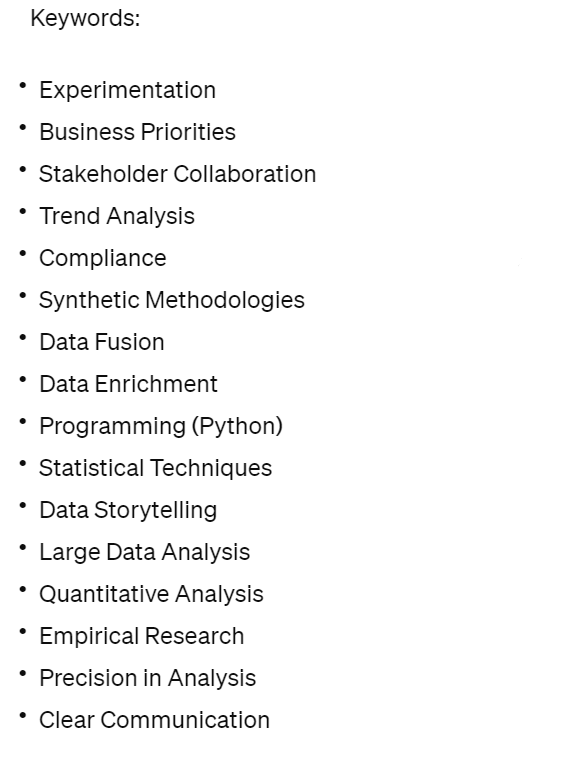
While some of the results were spot on, I found the majority of them were quite off the track from what we are trying to hire. For example, the titles like Business Analyst, Storytelling analyst etc and many more as you may see here are just not the right ones being used in the industry. This is where it becomes super important to have foundational knowledge of what you are asking AI to assist with.
Prompt 2:
Please write a 100–200-word email to a potential candidate for an [insert job title] role at my company [insert company]. The first paragraph in this email should summarize the role and provide an overview of our company. The second paragraph should outline the benefits and potential growth opportunities. Be friendly. Use a call-to-action, add a sense of urgency.

While this email highlights some of the data science aspects, for a potential candidate it may sound a bit generic and also does not stand out on personalization aspects. It’s imperative that the organizational value propositions are articulated well to reflect its core values and that is the key to drive talent attraction.
Prompt 3:
Example prompt: Provide a list of 50 groups for diverse [insert industry] talent.

Example follow-up prompt: Now build a Boolean string with the groups above using the operator OR.

(“Women in Data UK” OR “Women in Machine Learning & Data Science (WiMLDS) – London Chapter” OR “Women in Data Science (WiDS) – UK Chapter” OR “Women in Tech UK” OR “Women in AI UK” OR “Women in Big Data UK” OR “Women in STEM UK” OR “She Loves Data – UK Chapter” OR “Ada’s List” OR “TechWomen London”)
Simply copy this code and add it to your search query. However, it’s worth noting that this approach might not be the most effective for creating Boolean searches because it doesn’t cover all possible permutations and combinations, which are crucial for forming comprehensive Boolean search strings.
Using this list has proven to be very beneficial, offering more focused content than a general Google search could. For recruiters, this tool is incredibly valuable, not only for uncovering various channels to find talent but also for helping in discussions with hiring managers about the talent landscape, providing insights into the specifics of each avenue.
Prompt 4:
Write me an x ray search string to help me identify candidates for an [data scientist] role with experience in [geospatial]
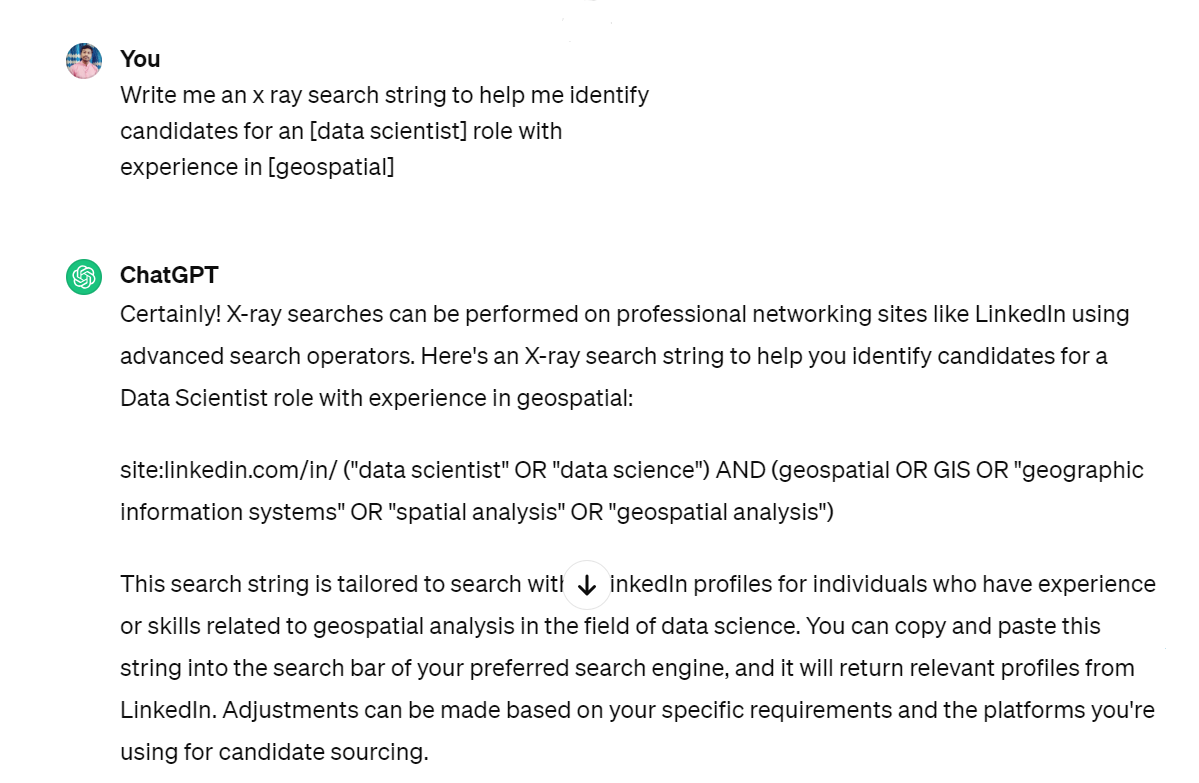
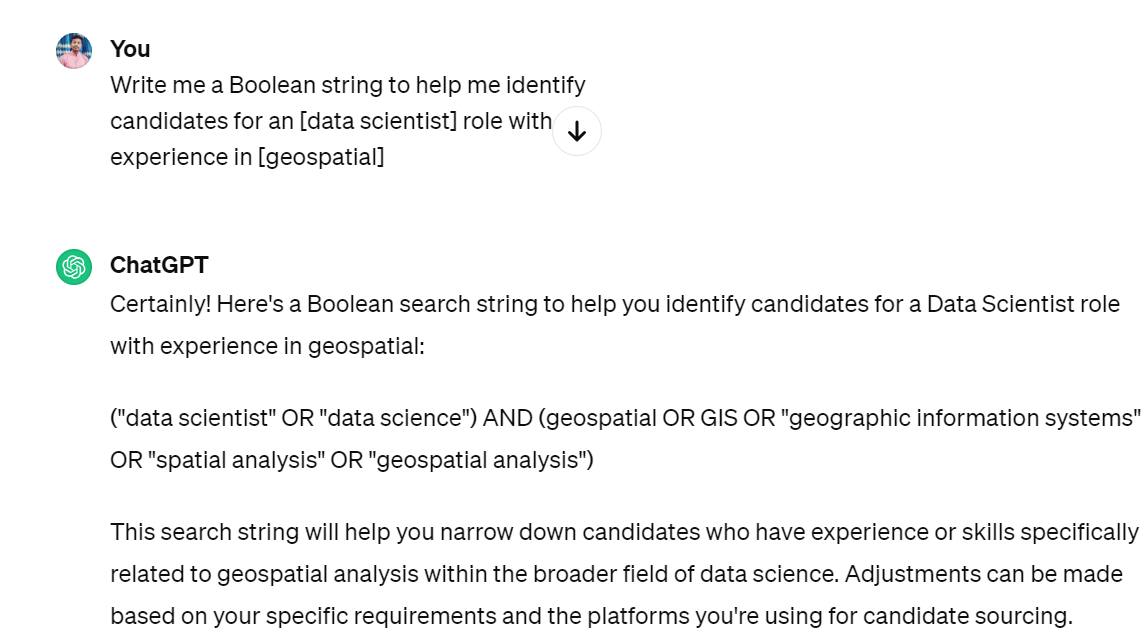
Though it resulted in an x-ray search string that pulls candidates from LinkedIn alone, it’s still a good place to start for someone who is not adept at writing x-ray search strings from scratch, at the same time not diluting the fact that there are numerous freebies available today that can help automate this part of the search. Nevertheless, it calls out the same as a message at the bottom which is quite useful.
Prompt 5:
I will provide you with a job description and I’d like you to rewrite it to be more [appealing/interesting/inclusive] to [engineers/parents/extroverts].
Here is the result from GPT.

Although there are many tools out there to help rewrite job descriptions, ChatGPT stands out by making everything simpler and faster with just one click. It’s really useful, especially for recruiters and hiring managers wanting to make their job ads more interesting and engaging.
Prompt 6:
As a recruitment specialist with over 10 years of experience, your task is to develop a talent intelligence report about the talent crunch in the advertising industry in 2023 for Manchester. Please provide a detailed report that highlights the key trends to look out for and the factors that require careful consideration. Also highlight which are the major players in the market where such talent can be scouted.
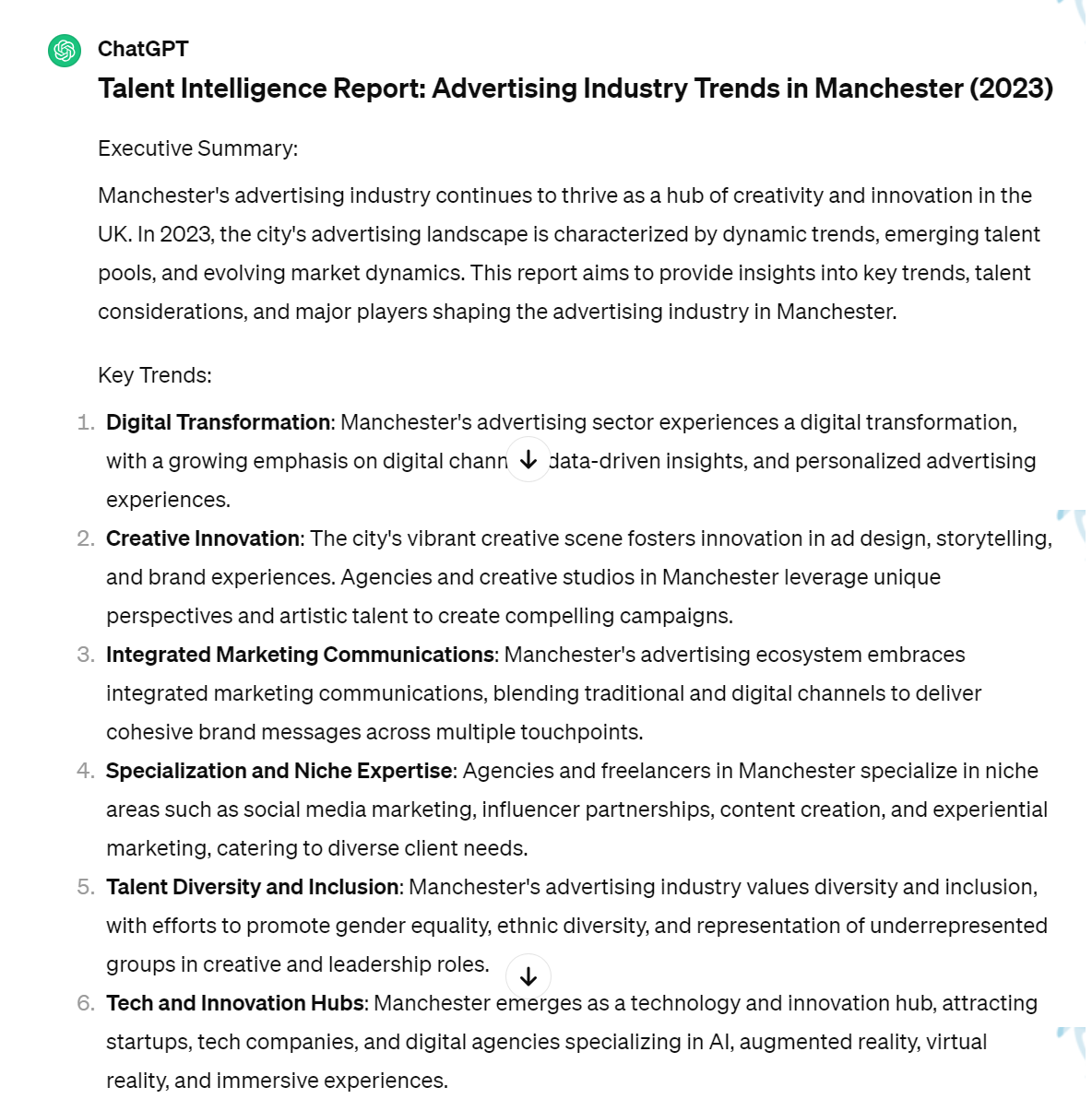

I’ve spent most of my career specializing in technology recruitment, gaining a strong understanding of the talent landscape over the years. For someone like me, this is a very important prompt to know about a different space and market, especially when I am going to meet a hiring manager who is looking to hire a media/advertising team, and the fact that it allows the flexibility to tie up some of the demographics like location turns out to be a game changer. While that is the case, it’s also important to ensure some of these points called out above are more generic in nature and do not give factual details. So, in case you aren’t prepared to go in detail on any of these, you will be in a tricky situation when there is a need to deep dive on the aspects. So please use and learn to use more, probe well to extract as much information as possible from the GPT so that you gain some good insights which may be an eye opener for the hiring teams and therefore help navigate through the recruitment process effectively.
Prompt 7:
Please generate 10 questions that I can ask a hiring manager to better understand what they are looking for in a [Search Account Manager] role. I will use these questions to ensure we source great candidates for this team.
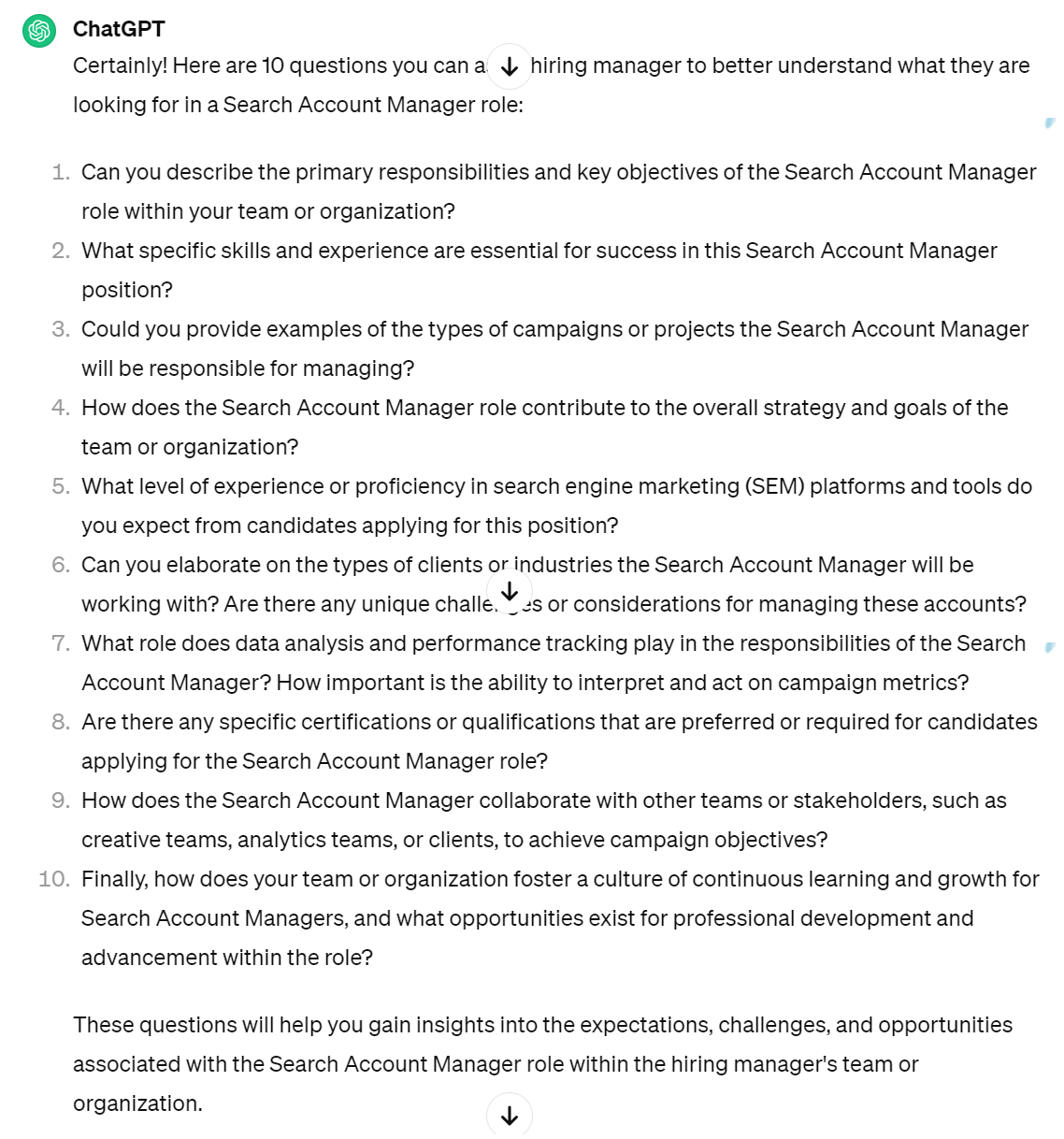
Eventhough the beginning parts of this result seemed pretty basic to me, there were still some good points, like the search engine marketing platforms and industry tips, that could really help you prep for an intake meeting. I would have ideally googled more to find specifics of such tools so that it not only gives you an overview of what to ask and how to navigate those conversations, but also help with better searches and Boolean strings. At the end of the day, it’s all about exploring and learning. Every search in recruitment is a journey you experience individually, and the takeaways are unquestionably unique to each of those journeys.
There are quite a few AI tools available today that help you with the way you interact with GPTs. One of them being Merlin, a powerful AI assistant that streamlines your interaction with GPTs. With a simple click of a button or using its convenient chrome extension, Merlin automates tasks and grants you easy access to various GPTs. Another noteworthy tool is Autopilot, which enhances AI capabilities in your MS Office applications. Additionally, prompt generators like Chat X and Promptperfect help you extract the full potential of GPTs. Chat X provides a user-friendly web interface for role-based prompt generation, while Promptperfect optimizes prompts for superior results. Promptperfect even gives a comparison of how your original prompt vs the generated prompts can optimize results from GPTs and its quite a cool feature.
In conclusion, Generative Pre-trained Transformers (GPTs) can comprehend your natural language during interactions but might not interpret things exactly as you do. It’s important to remember this distinction when incorporating AI into your workplace.
